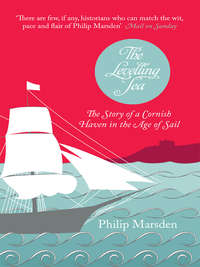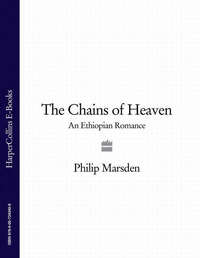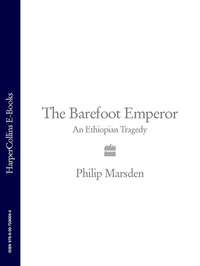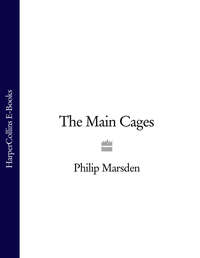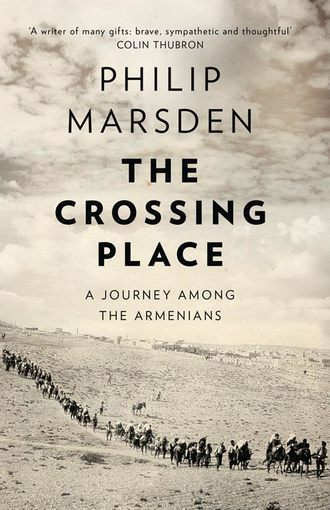
Полная версия
The Crossing Place: A Journey among the Armenians
South from the town of Hassakeh, the road ran straight ahead of the bus for mile upon mile. It dipped and rose and tapered towards a low horizon, but did not change direction. Beside it the telegraph poles echoed into the distance until the heat-haze dissolved everything into a shimmering mass. On Torkom’s map, Shadaddie was no more than a dot in the desert. A thin arrow pointed down to it from Ras ul-Ain. Now it has become an oil-drilling station and in one of the pre-fab homes I found a technician who nodded when I gave him Torkom’s letter: yes, he knew about the cave.
The technician drove me out of the town in a battered jeep. I sat half-hidden in the back and at the checkpoints crouched down behind the seat; we were now close to the Iraqi border and the oilfields were well guarded.
A dry wind swept through the flaps of the jeep. It sped out across the desert and into the jumble of hillocks ahead. It was a cool, unrelenting wind and in places it had scoured the sand from the bedrock and the quartzite gleamed beneath it as white as bone. Nothing grew here. The only things that moved were the lifeless profiles of the nodding-donkey pumps. We left the road and slowed on to a rutted track. All around it were the egg-like shapes of compacted dunes. We bumped along the track until the dunes gave way to a wide depression. The technician stopped the jeep and pulled on the handbrake. Lighting a cigarette, he pointed into the hollow.
Flash-floods had cut a deep gulch which pushed down into the rock below. I followed its dry pipe-like channel to where it opened out suddenly into the mouth of a cave. Peering into the cave-mouth, I could see the chamber spread out as if from the lantern of a dome. I dropped down onto a damp, muddy floor. Three startled doves flew out through the skylight. At the foot of one wall, where the sun fell on it, was a green cushion of moss. Down to one side a passage led away into the darkness. The air was warm and heavy and I felt that here, if anywhere, was the Armenian story – hidden inside a muddy cupola, in an area sealed off by state secrecy, tucked away and buried in a hollow amongst a thousand other hollows, beneath the crust of a desert that stretched for hundreds and hundreds of miles in every direction. Here was where Armenia had ended.
I turned on a torch and went down the passage. There was no sign at all of what had happened, nothing to show that it had ever been anything but a vast storm-drain for the desert.
But for the zaptieh, it had provided a ready-made solution. As the mountains were emptied of Armenians so the Syrian desert filled up. The order came from Constantinople to clean up the area. All sorts of methods were adopted. Shooting was slow. Some were driven into the river. A great many simply perished from disease and hunger and thirst. Shadaddie provided its own natural apparatus. The passage was very long and very roomy.
The guards brought the Armenians here and pushed them in by the thousand; as more fell in so the first ones were forced down the passage. Then the guards dragged scrub to the entrance and set fire to it. That night they kept a watch over the cave, camping on the edge of the hollow. Then they returned to the town.
They might have got away with it (are there other Shadaddies that went unreported?), had a young boy not been able to get enough air from the depths of the tunnel to survive and, three days later, to crawl over the bodies and the ashes of the fire, back up to the desert.
The passage went on, curving and dipping in ways I could only imagine. I could see little in the yellow tube of light. The air became still and I could no longer feel the breeze from the entrance. I felt drawn on into the tunnel by a strange irresponsible urge. Each footfall seemed to take me further from the familiar. I felt a huge emptiness behind me – but a bigger one in front. I was trespassing, a grave-robber motivated by something darker than greed: I was driven by curiosity. I knew there was nothing I would find, but I carried on. I carried on without really thinking. I carried on because to turn back was to lose what there was left of Armenia.
My feet slid and splashed through unseen puddles. I steadied myself with a hand on the damp wall. I could feel the tunnel narrow and I began to stoop. Then one foot slipped on a mud bank and the torch spun out of my hand; it clanged against a rock and went out.
For several minutes I squatted there, quite still. I passed a hand in front of my face, and saw nothing. I turned my head one way and then the other, and soon did not know from which way I had come. I tried to imagine the smell of smoke seeping down the tunnel, and the noise – would there have been hysteria, or simply quiet resignation? Mothers murmuring for their children in the void, the few men too broken to care, the tangled bodies, the slow suffocation …
For an instant I felt the cave spin around me. Submerged by the horror it had witnessed, I was suddenly disoriented.
It passed almost at once. I crouched and ran my hands around my feet, probing for the torch, wrist-deep in the slimy clay, pushing through the cave’s damp and formless floor. My fingers struck something hard. I clutched it and with the other hand found the torch, several yards away. I thought it must be another bone but when I switched on the torch it turned out to be a large crystal – five inches of transparent calcite in the shape of an arrowhead.
Outside again, the Armenian technician clapped a hand on my shoulder and smiled for the first time. He was worried I’d got lost. He lit another cigarette and started up the jeep. I wrapped the crystal in a scarf and buried it away in my bag. It seemed an appropriate relic from the cave: Armenia may have died here, but something survived. A year or so later, in Israel, I took it with my unanswered questions to Jerusalem.
The old city of Jerusalem, the holiest square mile on earth, is divided into four distinct quarters. Three of the quarters – the Jewish, Christian and Muslim quarters – represent the great monotheistic faiths that have sanctified and fought over the city for hundreds of years. The fourth quarter is the Armenian quarter.
That the Armenians have survived in this, the most intense of all cities, is proof of their extraordinary resilience. The Armenian quarter is in fact the longest established of them all – and it remains the most secretive. Much of it lies within its own high walls, where the laity live cheek-by-jowl with the monastic order of St James. It is closed to visitors and only for half an hour each day are non-Armenians allowed inside to visit the cathedral.
Peering into the side chapel of St James, which contains those of the saint’s limbs which did not reach Compostela, I heard a voice behind me.
‘Can I be of any help?’
A man with black-rimmed glasses introduced himself as George Hintlian, the community’s historian. I told him I had seen Ani and Digor and that I had brought something from the cave at Shadaddie.
‘I could tell you were not interested just in the cathedral.’
‘How could you tell?’
‘I could just tell.’
He took me up to his office and I laid the calcite crystal on his desk. He smiled and shook his head in disbelief. ‘Let me show you around the quarter.’
For several hours we wandered through a labyrinth of crypts and alleys and sunny courtyards. He took me up over the roofs and in amongst the cloisters to meet the monks, and when I left he said, ‘If ever you want to find out more about the Armenians, why not come and spend some time here with us?’
I left the crystal with George and within eighteen months I was back. My Armenian questions would not go away. I told George I wanted to get to Armenia and he said he could help. I stayed in Jerusalem for a few months, in a small, vaulted room on the border of the Jewish and Armenian quarters. The city was tense; Kuwait had just been invaded and all talk that autumn revolved around the likelihood of war. Jerusalem waited. The Israelis waited and the Palestinians waited; the Armenians waited between them. I waited – all the time planning a roundabout journey to Armenia, to seek out the Armenian communities that appeared to be scattered throughout the Middle East and Eastern Europe.
I took daily lessons in Armenian with a polyglot monk, took long walks with George, talked to everyone I could, and spent the rest of the time among the books of the Gulbenkian Library. I visited the Armenian community in Jaffa and a fifth-century Armenian monastery in the Judean desert; I spent a week with the Armenians of Cairo. And I realized more and more that the Armenian story was not so much one of massacre and persecution, as survival.
The first princes of Armenia had emerged in central and eastern Anatolia about six centuries before Christ. Five hundred years later, Armenia stretched fleetingly all the way from the Mediterranean to the Caspian Sea. At other times during these centuries the Armenian rulers paid tribute to the Persians, to Byzantium, to the Baghdad caliph, or some combination of the three. Even in these years Armenia’s survival seemed improbable. Lying always on the fringes not only of opposing powers but opposing beliefs, the Armenians would adhere to no one’s ideas but their own. In AD301 the Armenian King Trdat III became the first ruler to adopt Christianity – while in Rome the worst persecutions of Christians were yet to come.
When some years later Constantine chose the outlawed cult to be the cornerstone of Byzantine theocracy and the world’s greatest empire, the Armenians still stuck to their own interpretation. In 451, at the Council of Chalcedon, the Byzantine bishops agreed some sort of Christian orthodoxy; the Armenians didn’t even turn up – they were too busy fighting off the Sassanid Persians.
Even the earth itself seemed to conspire against them. Within a few hundred miles of Ani are the borders of half of the world’s twelve major tectonic plates. In a single earthquake in the ninth century, seventy thousand were recorded as having been killed in one Armenian town alone.
Yet during this first Christian millennium, between the earthquakes and invasions, between the Mazdaeans, Manichaeans, Muslims, dyophysites and dualists, the Armenians emerged briefly to stage brilliant half centuries of their own, writing and building with passionate skill, before being stifled again by some rampant horde. In the ninth century Armenia emerged again as an independent state, centred on the city of Ani. I had caught a scent of that city’s genius, sitting in its ruined cathedral a few years before. At one time Ani was bigger than most European cities. But in 1064 the Seljuk Turks swept up out of Asia and sacked it.
What should have happened then to this small people, occupying as it does the perennial buffer between empires, the most routed, trampled-over region on earth, was a gradual assimilation into its bigger and more powerful neighbours. Its scattered families should have struggled on for a couple of generations in exile, clinging proudly to traditions before intermarriage consigned them to history’s roll of honour: a set of dusty ruins on the Anatolian plateau and some glass cases in the British Museum.
Instead the Armenian princes travelled five hundred miles to the south-west. There in the lee of the Taurus mountains, in Cilicia, they established a new Armenian kingdom. Many of those who didn’t flee and who weren’t killed by earthquakes nor slaughtered during the Seljuk invasion, but who remained on the land, were driven in 1604 by the Safavid Shah Abbas down into Persia. And those who survived both the Seljuks and Shah Abbas, and who didn’t drift away beyond the Ottoman empire, who weren’t killed in the pogroms of the 1890s, nor those of 1909, but who stayed in the villages, were rounded up in 1915, pushed down one of history’s dark side-alleys and murdered.
More than a million Armenians died in the last years of the Ottoman empire, a half of Anatolia’s total. The Turks had managed to do what numerous powers had tried before them: they managed to finish Armenia, though not the Armenians. In most of the world’s cities you can find Armenians – Armenian newspapers in Armenian script, Armenian restaurants. In exile the Armenians are curiously resilient; only the Jews have resisted assimilation as fiercely. In the mountains of Colombia there is a small town actually named Armenia where they serve ‘Antioch-style’ beans. In Paris the first-ever café was opened in 1672 by an Armenian, as it had been earlier in Vienna, by the same Armenian spy who had helped break the Turkish siege. At the siege of Vienna the Polish King Jan’s private doctor had been an Armenian, as was the doctor to the harem of Akbar the Great, the Mogul emperor whose adopted Armenian son was regarded by the Jesuits in India as the greatest poet of his time.
The ‘Polish Byron’, Słowacki, had an Armenian mother, as does the chess-master Garry Kasparov, as did Gurdjieff, as did the Abbasid Caliph al-Mustadi who ruled the entire Arab world during the twelfth century, except for Egypt where a few years earlier Armenian vizirs held power, and Jerusalem where the hereditary Crusader rulers had long had Armenian blood coursing through their royal veins. When Richard the Lionheart was married, in Cyprus, his best man was an Armenian; the last king of Armenian Cilicia, exiled in France, taught the French king to play chess. It has even been suggested that the Man in the Iron Mask was none other than the Armenian patriarch of Constantinople.
The first yoghurt in the United States was manufactured by the Armenian family Columbissian. The particular green ink of the US dollar bills was developed by an Armenian, as was the MiG jet, named after Mikoyan, whose brother was the longest-standing member of Stalin’s Politburo, and the first to denounce him. Abel Aghanbekyan, an Armenian economist, produced the blueprint for perestroika.
They shouldn’t really exist at all. They should have been destroyed, written out of history by its worst horrors. But they have survived. Instead of a footnote to the story of these border regions, the Armenians can be read like a kind of subtext.
With the Gulf War imminent, the Soviet Union crumbling and Eastern Europe in a state of dangerous uncertainty, it seemed the perfect time to set off around the Armenian diaspora, to try and reach Armenia itself. I prepared to leave Jerusalem.
In the library of the Armenian quarter, tacked to the wall, were the lines of the Armenian writer William Saroyan:
I should like to see any power of the world destroy this race, this small tribe of unimportant people, whose wars have all been fought and lost, whose structures have all crumbled, literature is unread, music is unheard, and prayers are no more answered. Go ahead, destroy Armenia. See if you can do it. Send them into the desert without food or water. Burn their homes and churches. Then see if they will not laugh, sing and pray again. For when two of them meet anywhere in the world, see if they will not create a New Armenia.
Wondering what Saroyan meant by a ‘New Armenia’, and wondering what remained of the old, I said goodbye and left the monastary on a damp December evening. I headed for Venice, where there had been an Armenian community for more than eight hundred years.
I THE NEAR EAST
They chose the Worst Thought, and then ran to join Wrath.
From the Zoroastrian Gāthas, yasna 303, in which the Deceiver tricks God into letting man acquire the wrong spirit.
1
I was looking a long while for Intentions,
For a clew to the history of the past for myself, and for these chants – and now I have found it,
It is not in these paged fables in the libraries (them I neither accept nor reject,)
It is no more in the legends than all else,
It is in the present – it is this earth today.
Walt Whitman
Venice was cold. Small ice floes littered the canals and drifted into the lagoon like soggy notes. No one lingered long outside; the piazzas were empty. But it wasn’t just the cold. From the balustrade of a palazzo on the Grand Canal, the students had draped a banner: NO ALLA GUERRA! NO ALLA CATASTROPHE! The catastrophe for the Venetians was that the Gulf war was scaring away the tourists. I had the place almost to myself.
The Mourad-Raphaelian school was the only one for the children of Venice’s Armenian community. Its director looked more Italian than Armenian; he wore scarlet socks and walked with short, urgent strides. I met him hurrying away from the school. ‘Please,’ he called back, ‘wait inside! My car is in the middle of the road. It is broken.’
‘Your car?’ In Venice? But he was already gone.
I pushed open the school’s heavy oak door and entered a panelled hall. Bright sun fell across the flagstones, and through the windows was a small courtyard. But there was no sign of life. Upstairs it was the same – bare floors and echoing corridors. It seemed more abandoned palace than school. Only the walls and ceiling, flourishes of rococo plaster, gilded swags and voluptuous oils, seemed alive. Too alive, in fact. The overnight train to Venice had been a sleepless affair, and so much early-morning baroque made me a little nauseous. I found a window overlooking the canal and watched the sunlight flicker on its filmy surface.
The Armenians have long been in Venice. When it emerged as a power in the twelfth century they were already well established. Their talent for innovation, an exile’s talent, litters the chronicles of the republic. Sinful Hagop set up a printing press in 1514 and produced the first Armenian printed book, while Anton Surian – ‘Anton the Armenian’ – built ships. Twice his own designs had helped save Venice: once with a frigate whose beam-mounted cannon swung the battle of Lepanto, and then again with a salvage ship that unclogged centuries of broken ships from the lagoon. But in recent years the community has been whittled away to almost nothing. Many of the old families have gone to Milan.
The director returned and showed me into a high-ceilinged office. The walls were refreshingly plain and hung with the familiar icons of Armenian exile: a view of Ararat, and large colour plates of half-ruined churches, standing alone in the mountain wastes of western Armenia, old Armenia, Turkish Armenia.
‘Yes,’ sighed the director. ‘Not many are left here. You know, it’s a full-time job being an Armenian.’ He stretched his arms open wide, nodding at each of his hands. ‘Here … and here. I struggle to keep up with my brother in Syria and Egypt, in America and Persia. If I relax for an instant, it is gone!’ His arms flopped to his sides. ‘You understand?’ He picked up the telephone and tried to track down a mechanic.
Running a car in Venice also seemed a full-time job, so I thanked him and walked out again into the frosty streets.
I telephoned Father Levon Zekiyan and we arranged to meet in a small café near the Chiesa San Rocco. Father Levon held Venice’s chair of Armenian studies. He was a tall man, with a distinct sartorial elegance. I’d been given his name in Jerusalem, but I’d seen it too at the head of various scholarly papers. He’d written a great number of papers, in several languages, and his footnotes were always a maze of different scripts. Enthusiasm for the minutiae of Armenian history set his conversation darting around the centuries, but did not make him shy of the broad sweep. When I asked him the big question – what keeps the Armenians Armenian – he paused for only a moment.
‘The whole thing,’ he explained, ‘comes down to a single idea. And the key to it is the script. Mesrop Mashtots was our greatest political thinker! In the fifth century he invented the alphabet – he realized Armenia as a power was finished. If the Armenians were to survive without territory, they had to have a common idea, something that was theirs alone. The script embodies the idea.’
‘And what is the idea?’
‘Ah, you cannot describe it! You can give it a name but you cannot describe it. If you are lucky, you will come to know it a little.’ He took a sip of wine and smiled. ‘Our poet Sevak called it simply Ararat.’
Ararat – of course. Ararat echoes around things Armenian like a persistent cliché. It is the name of Armenian journals, Armenian books, Armenian businesses and restaurants; in the United States there is an Armenian credit card called Ararat, as is an Armenian nursing home in California. The national football team is called Ararat, and the mountain’s dual-peaked profile had hung in every Armenian home I’d seen so far. I knew it as a symbol of exile, staring as it now does into Armenia from across the Turkish border. But Father Levon’s idea was much more than that. I began to see the mountain as something more enigmatic: an article of faith, the survival of an animistic past.
Osip Mandelstam, after several months in Armenia, also became aware of Ararat’s peculiar presence:
I have cultivated in myself a sixth sense, an ‘Ararat’ sense: the sense of attraction to a mountain.
Now, no matter where fate carry me, this sense already has a speculative existence and will remain with me.
I had seen Ararat too – from Dogubeyazit in Turkey. But it had left no particular mark on me. Perhaps I had to wait to see it from Armenia.
I left Father Levon in the Piazza San Marco and took a boat across the lagoon to the island of San Lazzaro. The afternoon was crisp and beautifully clear. Only two other passengers were on the boat; one of them was an Armenian monk. For more than two hundred and fifty years, San Lazzaro has been an Armenian monastery. It is now one of the great storehouses of Armenian culture, with its collection of thousands of manuscripts – pages and pages of Mesrop’s script.
The monk from the boat passed me on to another monk who guided me around the monastery, Climbing the stairs to the museum, he asked me for news of the Armenian monastery in Jerusalem. I went in to some detail about the new patriarch and the bishops and the old retainers of the Holy Places, but I could see he had lost interest; they were members of the Brotherhood of Saint James, he was a Mekhitarist, a wholly different sect.
San Lazzaro’s museum, on the other hand, was a testament to the cohesion of the diaspora. Each exhibit, brought to the island by devoted pilgrims, was another dot on the Armenian map. It was like the collection of some well-travelled Victorian philanthropist. Under a Tiepolo ceiling, Persian ceramics stood with Iznik dishes and Kutahya ewers; there was an ivory Taj Mahal, some ivory filigree orbs (seven inside one another, like a Russian doll), a silver Ethiopian hand cross, St Petersburg miniatures, stamps, banknotes, a Crusader sword, a Canova cast of Napoleon’s son, a Burmese boustrophedon manuscript explaining in Pali the initiation rites of a Buddhist priest, and a mummy. In 1925 Egypt’s foreign minister, an Armenian, had brought the mummy, along with a Bubastis cat. The mummy was the monk’s favourite exhibit.
He led me away from the main gallery to a room lined with the buckram spines of English classics. There, hanging over the door, was a portrait of Lord Byron. All through the winter of 1816, several times a week, Byron crossed the lagoon to visit the monks of San Lazzaro. He developed a fascination with Armenia, discovering among other things that it was the supposed site of Earthly Paradise.
‘Their country,’ he wrote, ‘must ever be one of the most interesting on the globe.’
In this room Byron took on the Armenian language. His letters tell of his endeavours: ‘In the mornings I go over in my gondola to hobble Armenian with the friars … my mind wanted something craggy to break upon … this was the most difficult thing I could discover … a Waterloo of an alphabet …’ In Venice itself, his pursuits were easier:‘… the lady has, luckily for me, been less obdurate than the language …’ After some months his visits to San Lazzaro dried up.
The next day, before leaving Venice, I called ahead to Cyprus. I told Garo Keheyan, an Armenian I’d met in Jerusalem, that I planned to be in Nicosia in a few days.





